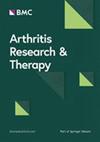软骨细胞特异性敲除Piezo1和Piezo2对小鼠创伤后骨关节炎结构损伤和疼痛有保护作用
IF 4.6
2区 医学
Q1 Medicine
引用次数: 0
摘要
骨关节炎(OA)是一种以软骨退行性变、滑膜炎症和骨重塑为特征的衰弱性关节疾病,针对潜在病理生理的治疗选择有限。机械敏感离子通道Piezo1和Piezo2在软骨细胞对机械应力的反应中起着至关重要的作用,介导影响软骨细胞存活、基质产生和炎症信号的机械转导途径,但它们在OA发病机制中的具体作用尚不清楚。利用诱导的软骨细胞特异性agrecan - cre (Acan)小鼠,我们研究了Piezo1、Piezo2和联合Piezo1/2条件敲除(kcos)对雄性和雌性小鼠创伤后OA内侧半月板(DMM)模型的破坏作用。在四个时间点进行疼痛和行为评估以评估OA进展,而软骨损伤,骨重塑和滑膜炎症在28周的最终终点进行评估。统计分析包括单向和双向方差分析,采用Tukey多重比较检验。Piezo1 cKO延迟疼痛发作,但最终加重软骨退化和滑膜炎,强调其在保护性和致病性机械转导中的双重作用。虽然Piezo2 cKO减轻了疼痛并保持了活动,但它不能保护软骨。值得注意的是,Piezo1/2 cKO对软骨变性、滑膜炎和疼痛提供了最大的保护。微计算机断层扫描分析显示,Piezo2对于维持骨小梁的完整性至关重要,而Piezo2 cKO会导致骨体积、厚度和密度下降,与损伤无关。Piezo2 cKO还能降低小鼠随着年龄增长而发生的正常半月板骨化。相比之下,在Piezo2 cKO小鼠中观察到的Piezo1/2 cKO使大多数骨重塑参数正常化,但没有恢复胫骨平台内侧厚度,突出了Piezo2在骨结构中的重要作用。这些发现证明了Piezo1和Piezo2在OA发病机制中的重叠和代偿作用。Piezo1和Piezo2的双重抑制可能提供一种针对疾病结构和症状方面的新颖有效的治疗策略。本文章由计算机程序翻译,如有差异,请以英文原文为准。
Chondrocyte-specific knockout of Piezo1 and Piezo2 protects against post-traumatic osteoarthritis structural damage and pain in mice
Osteoarthritis (OA) is a debilitating joint disease characterized by cartilage degeneration, synovial inflammation, and bone remodeling, with limited therapeutic options targeting the underlying pathophysiology. Mechanosensitive ion channels Piezo1 and Piezo2 play crucial roles in chondrocyte responses to mechanical stress, mediating mechanotransduction pathways that influence chondrocyte survival, matrix production, and inflammatory signaling, but their distinct contributions to OA pathogenesis remain unclear. Using inducible, chondrocyte-specific Aggrecan-Cre (Acan) mice, we investigated Piezo1, Piezo2, and combined Piezo1/2 conditional knockouts (cKOs) using the destabilization of the medial meniscus (DMM) model of post-traumatic OA in male and female mice. Pain and behavioral assessments were conducted at four time points to evaluate OA progression, while cartilage damage, bone remodeling, and synovial inflammation were assessed at the final endpoint of 28 weeks. Statistical analyses included one-way and two-way ANOVA with Tukey’s multiple comparison test. Piezo1 cKO delayed pain onset but ultimately exacerbated cartilage degradation and synovitis, emphasizing its dual role in protective and pathogenic mechanotransduction. While the Piezo2 cKO reduced pain and preserved activity, it failed to protect cartilage. Notably, Piezo1/2 cKO provided the greatest protection against cartilage degeneration, synovitis, and pain. Micro-computed tomography analyses revealed that Piezo2 is critical for maintaining trabecular bone integrity, with a Piezo2 cKO leading to decreased bone volume, thickness, and density, independent of injury. Piezo2 cKO also reduced normal meniscal ossification that occurs with age in mice. In contrast, a Piezo1/2 cKO normalized most bone remodeling parameters observed in Piezo2 cKO mice but did not restore medial tibial plateau thickness, highlighting Piezo2’s essential role in bone structure. These findings demonstrate the overlapping and compensatory roles of Piezo1 and Piezo2 in OA pathogenesis. Dual inhibition of Piezo1 and Piezo2 may offer a novel, effective therapeutic strategy targeting both structural and symptomatic aspects of the disease.
求助全文
通过发布文献求助,成功后即可免费获取论文全文。
去求助
来源期刊

Arthritis Research & Therapy
RHEUMATOLOGY-
CiteScore
8.60
自引率
2.00%
发文量
261
审稿时长
14 weeks
期刊介绍:
Established in 1999, Arthritis Research and Therapy is an international, open access, peer-reviewed journal, publishing original articles in the area of musculoskeletal research and therapy as well as, reviews, commentaries and reports. A major focus of the journal is on the immunologic processes leading to inflammation, damage and repair as they relate to autoimmune rheumatic and musculoskeletal conditions, and which inform the translation of this knowledge into advances in clinical care. Original basic, translational and clinical research is considered for publication along with results of early and late phase therapeutic trials, especially as they pertain to the underpinning science that informs clinical observations in interventional studies.
 求助内容:
求助内容: 应助结果提醒方式:
应助结果提醒方式:


